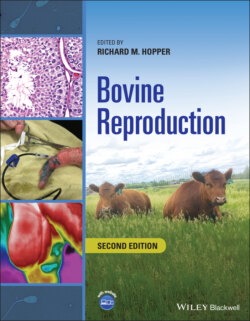Читать книгу Bovine Reproduction - Группа авторов - Страница 36
The Scrotum and Spermatic Cords
ОглавлениеThe scrotum is composed of an outer layer of thick skin and three underlying layers, the tunica dartos, the scrotal fascia, and the parietal vaginal tunica. The scrotal skin is extensively populated with numerous large adrenergic sweat and sebaceous glands that are highly endowed with thermal receptors and nerve fibers. Neural stimulation from the thermal receptors enables the tunica dartos, which consists of smooth muscle fibers and lies just beneath the scrotal skin, to contract and relax in response to changes in temperature gradients and facilitates the cooling of the scrotal surface via scrotal glandular sweating [19]. Thus the scrotum not only plays an important role in housing and protecting the testes but also has a role in thermoregulation of the testes. The spermatic cord connects the testes to the body and provides access to and from the body cavity for the vascular, neural, and lymphatic systems that support the testes. In addition, the spermatic cord accommodates the cremaster muscle, the primary muscle supporting the testes, and the pampiniform plexus, a complex and specialized venous network that wraps around the convoluted testicular artery [21]. This vascular arrangement is very important in temperature regulation of the testicular environment. The plexus consists of a coil of testicular veins that provide a counter‐current temperature exchange system: this is an effective mechanism whereby warm arterial blood entering the testes from the abdomen is cooled by the venous blood leaving the testes. Testicular arteries originate from the abdominal aorta and elongate as the testis migrates into the scrotum [19]. In cattle and other large domestic ruminants these arteries are highly coiled, reducing several meters of vessel into as little as 10 cm of spermatic cord [19]. The arterial coils and venous plexus are complex structures that form during fetal life in cattle [19, 22]. Because of the pendulous nature of the bovine scrotum, testicular cooling is facilitated by the contraction and relaxation of the cremaster muscle, which draws the testes closer to the abdominal wall during cooler ambient temperatures and vice versa during warmer temperatures. Figure 2.1 shows bright‐field and thermal images of the bovine testes that demonstrate the change in temperature from the neck to the tip of the scrotum as the testes thermoregulate during elevated environmental temperatures. Scrotal and testicular thermoregulation is a complex process involving a number of local mechanisms that strive to maintain the testes at environmental and physiological conditions conducive for normal spermatogenesis. For additional reading on testicular thermoregulation in the bull the reader is referred to the review by Kastelic et al. [23] and Chapter 4 of this book.
Figure 2.1 Bright‐field and thermal images of two‐year‐old Hereford bull testes. The images were taken using an FLIR SC600 thermography unit (FLIR Systems Sweden, AB) on 25 June 2013 at midday with atmospheric temperature of 29 °C and humidity of 75%. (a) Bright‐field image of the testes. (b) Thermal image of the testes as seen in (a), identifying three regions of interest (RO1, RO2, and RO3) as indicated by the vertical bars along which temperature values were obtained by means of the software ThermaCAM Research Pro 2.7. The image is pseudo‐colorized with temperature scale bar to help visualize the change in temperature gradient from scrotal neck to scrotal tip. (c) Temperature values, minimum (Min), maximum (Max), the difference between Min and Max, average (Avg) temperature for each region of interest (RO), and standard deviation (St dev) which assess the variation of temperature in each region. Note the almost 4 °C change in average temperature from RO1 to RO3.
